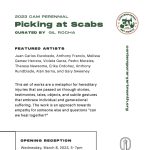Juan Carlos Escobedo
Juan Carlos Escobedo (B.1985 El Paso,TX) explores his identity as a queer, brown, Mexican-American, raised in a low-socioeconomic community along the US/Mexico border. His work addresses residual class and race shame that arises from living in a predominantly white structured United States which favors light-skinned individuals and middle-class and above socioeconomic classes.
Escobedo received his BFA from New Mexico State University and MFA from Massachusetts College of Art and Design. His work has recently been exhibited in San Antonio at Blue Star Contemporary, Centro de Artes, and The Southwest School of Art; in Boston at MassArt X SOWA; and in Darmstadt Germany at Darmstädter Sezession for The World Heritage Festival.
His work has been recognized through awards,including a Collective Futures Fund Grant from Tufts University Art Galleries: Andy Warhol Foundation for the Visual Arts as a consultant; an Actos de Confianza Grant from the National Association of Latino Arts and Cultures; residencies at Casa Lü in Mexico City, at Houston Center for Contemporary Craft, and at the Künstlerhaus Bethanien facilitated by Contemporary at Bluestar
Resume (PDF)
Work Samples (PDF)
MORE ABOUT THIS ARTIST
Artist Medium: Acrylic; Audio/Sound; Collage; Fiber/Fabric; Oil; paper, cardboard, video
Artist Statement of Work
I originally committed to using cardboard as a primary making material during graduate school, which was at a predominantly white, middle-class, institution located in Boston, MA– a stark difference from the brown, Spanish-speaking city of El Paso TX which I am from. I used this material because it was available,practical, and I was aware that it could be used for more than just packaging. My family in Cuidad Juárez used it as the principal building material for their homes. As I used it for object making, people overly questioned its presence, they encouraged me to cover its brownness, or they were simply offended by it. My identity underwent a similar amount of scrutiny— my American citizenship was questioned, I was encouraged to diminish my brownness, and people felt uncomfortable discussing my socio-economic background. This forced me to evaluate myself in spaces that were not originally aimed at people with my socioeconomic background or race. I used cardboard more adamantly because its identity is charged with "negative" perceptions and physical traits similar to mine. This led to the creation of "Cartone by J.ESC" , a fictitious fashion line with accompanying catalog descriptions. With each satirical description, I offered alternatives to expensive clothes, but warned the viewer of the social implications that arise from wearing a garment that is charged with "undesirable" socioeconomic and racial characteristics. Through humor, I intended to make the audience complicit in normalized negative perceptions of "lowbrow" materials and brownness. As I continued working something changed. I introduced landscapes and miniature homes made out of white materials. These new spaces are replicas of movie and t.v. homes I YEARNED to inhabit as a kid. They were spaces that were aspirational to my young self and which allowed a brief escape from my reality. People really responded to the new change in the J.ESC series. The miniature white spaces began to validate the haphazard brown landscapes and homes I had made previously... and so, a new parallel between these objects and myself appeared. I realized that I am no longer just a brown individual with features like the brown cardboard, but that through my education, I acquired a code of whiteness that validated my brown identity. This white code allows me to maneuver through professional and academic spaces that my previous self was not privy to. This is similar to the perception of the "valid" structure of the white homes. They exist, unquestioned and admired, but the only difference between them and the brown homes is 90 degree angles and color. The funny thing is that all white paper starts off as brown and is merely bleached of its original color. In the pursuit of these aspirational white spaces, my identity has undergone some whitewashing and deracialization, and I foolishly shed central aspects of my brown identity. Now I am in constant negotiation with these selves. These clothes are a physical manifestation of what has been described as "the gentrification of a brown body" where the resentment and tension between these identities is palpable.






